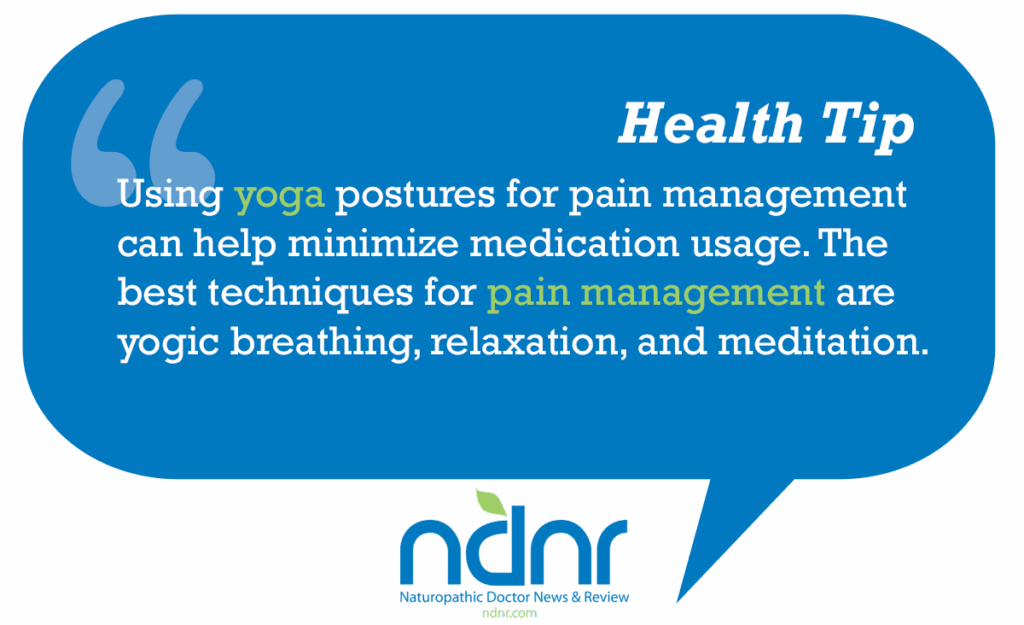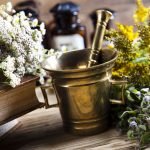Chronic Pain Syndrome and Ayurved
Virender Sodhi, MD (Ayurved), ND
Pain is the most common complaint that leads patients to seek medical care. Chronic pain syndrome is a poorly defined condition that presents a major challenge to healthcare providers because of its complexity. Most physicians consider ongoing pain lasting longer than 6 months as diagnostic, while others have used 3 months as a basic criterion. Still some physicians suggest any pain persisting longer than a reasonable length of healing time should be considered chronic.
Approximately 35% of Americans have some element of chronic pain, and approximately 50 million Americans are disabled partially or totally due to chronic pain. Major effects in the patient’s life with chronic pain syndrome are depressed mood, reduced activity and productivity, fatigue, reduced libido, excessive use and abuse of drugs and alcohol, dependent behavior, and disability. This condition is managed best with a multidisciplinary approach, requiring good knowledge of multiple organ systems. Naturopathic and Ayurvedic approaches with nutrition, physical exercise, yoga, breathing exercises, meditation, and detoxification along with the use of anti-inflammatory agents and adaptogens are the best approach to chronic pain management.
The pathophysiology of chronic pain syndrome is multifactorial and complex and still is poorly understood. Some researchers have suggested that it might be a learned behavioral syndrome that begins with an abnormal stimulus that causes pain. While acute pain is a normal sensation triggered in the nervous system to alert one to possible injury and the need to take care of one’s self, chronic pain is different. Pain signals keep firing throughout the nervous system for weeks, months, or even years. This pain behavior then is rewarded externally or internally. The pain behavior then becomes reinforced, and it occurs with or without an abnormal stimulus. Internal reinforcers are fear, irritability, anger, frustration, sexual issues, responsibilities and many more; where as external reinforcers include such factors as attention from family members, friends, and physicians, along with medications, compensation, and time off from work.
Due to the complex etiology and the frequent presence of associated disorders, a thorough history is necessary for the physician to direct further evaluation and appropriate consultations. A detailed history of physical, mental, and emotional symptoms, along with history of relationship, sexual relationship, sexual abuse, work, stress, sleeping patterns, and exercise is imperative. A detailed review of the musculoskeletal, reproductive, gastrointestinal, urologic, and neuropsychological systems must be obtained as well. Lists of diseases are long and exhaustive and beyond the scope of this article. As needed, specific questions should be asked of particular patients, depending on their associated disorders. Patients with major depression, somatization disorder, hypochondriasis, or conversion disorder are prone to developing chronic pain syndrome. Stress single-handedly is a major contributing factor in chronic pain. Interestingly we all have noticed head, neck, back, low back, jaw, and shoulder pain with increased stress.
Ayurvedic Treatment
Ayurvedic medicine considers disease to be a mistake of the intellect (Pragya= Intelligence, Apradh= Mistake). Treatment options are geared towards normalizing and balancing the body at mental, emotional, spiritual and physical levels with detoxification, nutrition, yoga, exercise, breathing exercise, meditation, counseling, and herbal and mineral supplements.
Ayurvedic Nutrition
Ayurvedic nutrition is prescribed according to one’s body type and pathology. In general, nightshade family plants, Rutaceae family (citrus), dairy products, red meat, caffeine, sugar and alcohol are avoided. Patients are prescribed light digestible hypoallergenic foods. Patients are encouraged to consume more vegetables, fruits, nuts, and grains like rice, amaranth, quinoa, millet and buckwheat.
Ayurvedic Detoxification Program, Panchakarma
Ayurvedic medicine has elaborate detoxification procedures for various health conditions, known as Panchakarma treatments (5 detoxification methods). According to Ayurveda, our natural state is one of health, happiness and an inner sense of well-being. Health is defined as the body being clear of toxins, the mind being at peace, emotions being calm and happy, wastes being efficiently eliminated, and when the organs are functioning normally. In a busy, stressful and toxic world, our physical and mental systems accumulate toxins causing deterioration in bodily functioning. This eventually weakens our systems, which opens the door to chronic, degenerative, and non-specific disease development. These can evolve into serious specific diseases, ultimately damaging an individual’s health and wellness.
Panchakarma can help by reversing these negative effects of daily living. It can restore the natural state of health and wellness by cleansing the body of toxins, bringing balance into the system, and improving bodily function. According to Ayurveda, good health depends upon our capability to fully metabolize all aspects of life, assimilating that which nourishes and eliminating the rest. When we can’t completely digest our food, experiences and emotions, toxins accumulate in our bodily tissues, creating imbalance and ultimately disease. Panchakarma is an elegant cleansing process that releases stored toxins and restores the body’s innate healing ability.
Treatments are mainly divided into 3 parts. First, preparation for cleansing, which is called Poorva Karma and involves internal and external oleation treatments, or Snehan. Internal oleation is achieved by consuming medicated ghee or other oil preparations. External oleation is achieved by massaging a medicated oil preparation into the body and working on specialized points called Marma Points (very vital points, very comparable to acupressure and acupuncture points). Fats have the unique ability to bind to many organic solvents, insecticides, pesticides, hydrocarbons, plastics and many more. This treatment is followed by Swedan, or sweating treatments, which is achieved by many different methods. The patient usually goes under a number of these treatments along with a hypoallergenic diet according to their Ayurvedic psychosomatic body type and pathology, yoga postures, breathing exercises and meditation.
The second part is the main detoxification, which includes therapeutic vomiting known as Vaman, which I have replaced by modified fasting as Americans are usually very averse to the thought of throwing up.1,2 Purging, known as Virechan, is achieved by utitlizing purging herbs to cleanse the small intestine, liver and spleen.3 Medicated enemas known as Basti are administered, cleansing and then restoring the functions of bowel.4 Nasal treatments, medicated oils, and herbal solutions are administered into the nostrils to detoxify nasal passages and sinuses and restore balance in the olfactory senses. This treatment is called Nasya.5 The last treatment is known as Rakt Mokshan, or bloodletting. This was achieved by many different methods, including the use of leeches. I usually encourage selected patients to go for blood donation. Research concurs that people who donate blood live longer, possibly due to diluted toxic load. I believe that females live longer than males because of menstruation, which constantly cleanses them. After the main detoxification, adaptogens are administered to rejuvenate and create a balance in the body.
I have found Panchakarma treatments to be very effective in almost all kinds of diseases, including chronic pain, and I have hundreds of success stories to share. A study published in September 2002 showed Panchakarma treatments to be very effective in lowering the number of lipophilic toxins. Serum levels of polychlorinated biphenyls (PCBs), trans-nonachlor (TNC), p,p’-dichlorodiphenyldichloroethylene (p,p’-DDE), oxychlordane, and hexachlorobenzene (HCB) were also markedly lower in the detoxification group. In the longitudinal evaluation, after treatment, mean levels of PCBs (46%) and ß-HCH (58%) declined significantly in the subjects.1
Exercise for Chronic Pain
People with chronic pain who exercise regularly require less medication and often have the same level of pain relief. Specific exercises decrease pain and strengthen muscles, tendons and ligaments. Endurance exercises reduce joint stress. Stronger muscles are less prone to microtrauma and fewer triggers for pain. Exercise done on a regular basis helps to improve sleep and boosts energy. A good exercise program will include proper alignment of body, mind, muscles, a good stretching program, and will have a core balancing endurance program. This should be done under the supervision of a trained professional. But one word of caution: too often overzealous personal trainers have made my patients with chronic pain suffer more. Choose a professional who has experience with chronic pain. But in spite of all the benefits, physicians do not very often prescribe it. According to a study published in 2009, only 14.4% of patients were prescribed exercise by their physician. Physical therapists were the ones who most often prescribed an exercise program.2
Yoga and Chronic Pain
Using yoga postures for pain management can help minimize medication usage. The best techniques for pain management are yogic breathing, relaxation, and meditation. These 3 aspects of yoga act to distract the mind from pain, reduce the body’s tension in reaction to pain, and provide an opportunity to “move through” the pain instead of resisting it so that it loses its impact. Yoga postures are believed to reduce pain by helping the brain’s pain center regulate the gate-controlling mechanism located in the spinal cord and the secretion of natural painkillers in the body.
Breathing exercises used in yoga can also reduce pain. Because muscles tend to relax when a person exhales, lengthening the time of exhalation can help produce relaxation and reduce tension. The act of controlling the breath in yoga also helps reduce pain. The body has a natural phenomenon built in to the nervous system that keeps tension in the muscles “on stand by” when the lungs are full. Relaxation training is a step-by-step process of relaxing each of the body’s muscles; this helps to counteract the body’s natural tendency to increase muscle tension in an unconscious effort to “push” the pain away – which only causes the pain to increase. Mental relaxation is more effective in the relief of chronic pain when combined with meditation and rhythmic breathing. I usually prescribe alternate nostril breathing for several minutes per day, and this has shown remarkable improvement in moods and reduction in pain level. A number of studies have shown positive outcomes with yoga postures and yogic breathing exercises, where patients have a lowered degree of anxiety, depression, stress, and pain, and an increased degree of optimism.3-6
Meditation and Chronic Pain
Meditation training is a conscious effort to reduce the mind’s constant chatter and to concentrate instead simply on the feeling of not thinking. Regular daily practice of meditation builds a foundation of internal strength by opening a door to a part of a person that is not governed by the demands of their physical body. A patient can start with 5 minutes of practice and build up the time slowly until you they do 20 minutes. They might want to try 2 20-minute sessions eventually, one in the morning and the other at night. A number of studies have been published to show beneficial effects of meditation in chronic pain. According to one study published out of Norway, patients with fibromyalgia showed improvement in working ability, generalized pain, tiredness, stiffness, tiredness on arising, anxiety, and depression when they followed an Ayurvedic lifestyle and meditation program.7,8
Ayurvedic Herbs for Pain Management
There are many Ayurvedic herbs that address ongoing excess inflammation. Among these are Salai (Boswellia serrata), proven in clinical studies to ease the pain of osteoarthritis; the prized spice turmeric (Curcuma longa); ginger (Zingiber officinale) known in Ayurveda as the “universal medication”; the powerful herb ashwagandha (Withania somnifera) and guggal (Commiphora mukul). Taken alone or in combination with other herbs, these natural pain relievers address chronic inflammation without the serious side effects of many pharmaceuticals. What follows is a sampling of my clinical experience using these herbs for pain relief and control.
Boswellia serrata
This herb is unrivaled as a treatment for osteoarthritis. In a 2008 double-blind, placebo-controlled study, Boswellia serrata produced very rapid results in patients with osteoarthritis, many of whom were bedridden. The patients’ pain scores and functional abilities were markedly improved, and blood levels of cartilage-degrading enzymes decreased.9 In another study, all of the osteoarthritis patients treated with Boswellia reported reduced knee pain, increased knee flexion, and increased walking distance. Swelling was also reduced considerably.10
I have used Boswellia with great success to treat patients with osteoarthritis, rheumatoid arthritis, and psoriatic arthritis. With holistic combinations of herbal therapy, Panchakarma detoxification, nutritional changes, and yoga, I have been able to take many patients off of prescription pain medications, including steroids.
Curcuma longa
My personal belief is that turmeric is responsible for the low cancer rate in India. Turmeric is a powerful antioxidant, anti-inflammatory, anticarcinogenic, antimicrobial, and hepatoprotective spice. India has the lowest rate of Alzheimer’s disease in the world and turmeric is thought to be that magic potion. I have used it with remarkable results in treating cardiovascular and gastrointestinal disorders.
As a pain-reliever, turmeric is potent in treating every aspect of inflammation. Various laboratory studies have demonstrated that turmeric’s active principle inhibits the action of inflammatory agents including phospholipase, lipoxygenase, cyclooxygenase 2 (Cox-2), leukotrienes, thromboxane, prostaglandins, nitric oxide, collagenase, elastase, and others.11
Cox-2 inhibitors such as celecoxib and rofecoxib were once touted as anti-inflammatory drugs without the side effects. However, many patients took these drugs for years before learning that they are associated with heart disease. Turmeric, on the other hand, has a much broader spectrum of anti-inflammatory activity than these drugs, and without the side effects. Turmeric has been used as a culinary spice in many areas of the world for centuries, and its safety for human consumption is well established. Curcuminoid, a bioflavonoid, is very poorly absorbed. This issue can be resolved by adding good lipids. Medium chain triglycerides are the best way to enhance the absorption, as curcuminoids are lipophilic.
Withania somnifera
Ashwagandha is an important Ayurvedic rasayana – a rejuvenating tonic that enhances longevity and may be used over a long period of time without side effects. Clinical studies have shown ashwagandha to relieve the pain of rheumatoid arthritis (RA). When the herb was given to a group of RA patients for a period of 4 weeks, more than half the paitents experienced pain relief. Some of these patients were completely free of pain and swelling after the herbal treatment.12
Ashwagandha is one of the Ayurvedic herbs that offers promise as an alternative to steroids. Its naturally-occurring steroidal content is much higher than that of hydrocortisone, a commonly prescribed anti-inflammatory. I always choose ashwagandha for patients with a need for steroids like hydrocortisone or prednisolone. Ashwagandha always comes to the rescue with flying colors, allowing such patients to reduce or eliminate their need for steroids.
Zingiber officinale
The medicinal value of ginger is so wide-reaching it is often called the “universal medicine.” I remember it as Grandma’s answer to everything – from stomach aches to headaches and joint pain.
Ginger is a powerful anti-inflammatory and antioxidant. It was studied in patients with RA in 2 clinical trials. In one, 7 RA patients reported pain relief, increased joint mobility, decreased swelling, and reduced morning stiffness.13
The second clinical study treated 28 RA patients, 18 osteoarthritis (OA) patients, and 10 patients suffering from muscular discomfort with powdered ginger at high doses over periods of up to 2½ years. Seventy-five percent of both the RA and the OA patients reported relief from pain and swelling. All 10 patients with muscular discomfort experienced relief. The patients who took higher doses of ginger experienced the fastest results. In another study, ginger relieved migraine headache.14
Commiphora mukul
In Ayurveda, guggal has long been used to treat inflammatory conditions like RA, OA, and psoriatic arthritis.
Conclusion
I have treated hundreds of patients with conditions including RA, OA, psoriatic arthritis, polymyalgia rheumatica, fibromyalgia, and asthma using the above-mentioned herbs in combination with nutritional changes, exercise, yoga, meditation and the Panchakarma detox program. I have been able to take patients off medications like methotrexate, etanercept, adalimumab, infliximab and prednisone after 3-16 months of Ayurvedic treatment. Even though my patients show tremendous improvement, I always advise them to stick to their nutritional program and lifestyle changes to ensure a lifetime of great health. I usually use combination formulas of standardized extracts of guggal with ashwagandha, turmeric, Boswellia and ginger, for a synergistic anti-inflammatory effect. Recently a patient with RA returned after 9 years to my clinic. She was treated with similar protocols and was in remission until now, when she went off her program and her symptoms returned.
Ayurvedic and naturopathic treatment modalities are effective in chronic pain management. We need to consider mental, emotional, physical and spiritual aspects of the disease.
 Virender Sodhi, ND, MD (Ayurvedic) is an internationally respected Ayurvedic and naturopathic physician, and one of the first to practice Ayurvedic medicine in the U.S. He received his MD (Ayurveda) after completing six years of medical training in India. He came to the U.S. in 1986 to share Ayurveda as part of a cultural exchange program. In 1988, Dr. Sodhi graduated from Bastyr University. Dr. Sodhi treats patients from all over the world at the Ayurvedic and Naturopathic Medical Clinic in Bellevue, Wash. He also lectures extensively throughout the U.S. and other countries, and is the founder of Ayush Herbs Inc.
Virender Sodhi, ND, MD (Ayurvedic) is an internationally respected Ayurvedic and naturopathic physician, and one of the first to practice Ayurvedic medicine in the U.S. He received his MD (Ayurveda) after completing six years of medical training in India. He came to the U.S. in 1986 to share Ayurveda as part of a cultural exchange program. In 1988, Dr. Sodhi graduated from Bastyr University. Dr. Sodhi treats patients from all over the world at the Ayurvedic and Naturopathic Medical Clinic in Bellevue, Wash. He also lectures extensively throughout the U.S. and other countries, and is the founder of Ayush Herbs Inc.
References
- Herron RE, Fagan JB. Lipophil-mediated reduction of toxicants in humans: an evaluation of an ayurvedic detoxification procedure. Altern Ther Health Med. 2002;8(5):40-51.
- Freburger JK, Carey TS, Holmes GM. Exercise prescription for chronic back or neck pain: who prescribes it? who gets it? what is prescribed? Arthritis Rheum. 2009;61(2):192-200.
- Saper RB, Sherman KJ, Cullum-Dugan D, Davis RB, Phillips RS, Culpepper L. Yoga for chronic low back pain in a predominantly minority population: a pilot randomized controlled trial. Altern Ther Health Med. 2009;15(6):18-27.
- Groessl EJ, Weingart KR, Aschbacher K, Pada L, Baxi S. Yoga for veterans with chronic low-back pain. J Altern Complement Med. 2008;14(9):1123-1129.
- Sherman KJ, Cherkin DC, Erro J, Miglioretti DL, Deyo RA. Comparing yoga, exercise, and self-care book for chronic low back pain: a randomized, controlled trial. Ann Intern Med. 2005;143(12):849-856.
- Bzdewka TM, Eissler-Russo JL, Galantino ML, Holbrook ML. The impact of modified hatha yoga on chronic low back pain: a pilot study. Alternative Therapies. 2004;2(10).
- Rasmussen LB, Mikkelsen K, Haugen M, Pripp AH, Førre ØT. Treatment of fibromyalgia at the Maharishi Ayurveda Health Centre in Norway. a six-month follow-up study. Clin Exp Rheumatol. 2009;27(5)(suppl 56):46S-50S.
- Kjellgren A, Bood SA, Axelsson K, Norlander T, Saatcioglu F. Wellness through a comprehensive yogic breathing program – a controlled pilot trial. BMC Complement Altern Med. 2007;7:43.
- Sengupta K, Alluri KV, Satish AR, et al. A double blind, randomized, placebo controlled study of the efficacy and safety of 5-Loxin for treatment of osteoarthritis of the knee. Arthritis Res Ther. 2008;10(4):85R.
- Gupta I, Gupta V, Parihar A, et al. Effects of Boswellia serrata gum resin in patients with bronchial asthma: results of a double-blind, placebo-controlled, 6-week clinical study. Eur J Med Res. 1998;3(11):511-514.
- Srimal RC. Turmeric: a brief review of medicinal properties. Fitoterapia. 1997;68(6):483-493.
- Anbalagan K, Sadique J. Influence of an Indian medicine (Ashwagandha) on acute-phase reactants in inflammation. Indian J Exp Biol. 1981;19(3):245-249.
- Mascolo N, Jain R, Jain SC, Capasso F. Ethnopharmacologic investigation of ginger (Zingiber officinale). J Ethnopharmacol. 1987;27(1-2):129-140.
- Mustafa T, Srivastava KC. Ginger (Zingiber officinale) in migraine headache. J Ethnopharmacol. 1990;29(3):267-273.








